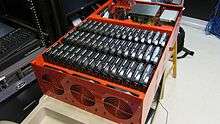Backblaze
 | |
| Developer(s) | Backblaze Inc. |
|---|---|
| Development status | Active |
| Operating system | Windows 10, Windows 8.1, Windows 8, Windows 7, Vista, XP, Mac OS X 10.5+ |
| Platform | Windows, Mac |
| Available in | English, French, German, Italian, Portuguese, Russian, Spanish, Simplified Chinese, Traditional Chinese, Japanese, Korean |
| Type | Online backup service |
| License | Proprietary |
| Website | www.backblaze.com |
Backblaze is an online backup tool that allows Windows and Mac OS X users to back up their data to an offsite data center. The service is designed for end-users, providing unlimited storage space[1] and supporting unlimited file sizes.[2]
Overview
Backblaze allows the user to back up data continuously, manually, when the computer is idle, or on an hourly schedule. The service makes use of AES encryption for security, and uses data compression and bandwidth throttling to reduce upload and download times. Files that need to be restored can be delivered in the form of a digital download,[3] on an external USB hard drive up to 4 TB or a USB flash drive up to 128 GB.[4]
Technology
Data replication
Data uploaded onto Backblaze's data center is sharded into 17 data shards plus three parity shards for each file. Parity shard bits are computed by the Reed–Solomon error correction algorithm. The shards are stored in 20 storage pods, each in a separate cabinet to increase resilience to a power loss to an entire cabinet. While Backblaze only has a single data center, Backblaze states that its Vault architecture is designed with 99.99999% annual durability.[5]
Encryption
Backblaze utilizes a combination of AES and SSL encryption to protect user data. All data is stored on Backblaze StoragePods encrypted with the user's private key, which is secured with the user's password and username. Users desiring additional security and privacy wishing to take a Trust No One approach may also use the passphrase system which encrypts the private key with a passphrase not stored on Backblaze servers. However, because decryption of private keys is done server side, this level of security is unlikely to protect against a government subpoena or serious data breach.[6]
StoragePod open design

In 2009 and 2011, Backblaze released CAD drawings of the computer case used by the storage servers in its datacenters. With commercial off-the-shelf components such as x64 processors, disks, and motherboards, high-density storage servers can be built at a lower cost than commercial ones.[7]
In February 2013, version 3.0 of the pod was introduced with increased storage capacity and other upgrades.[8]
In March 2014, version 4.0 of the pod was introduced which is faster, simpler and less expensive,[9] and then a "tweaked" version 4.5 in March 2015.[10]
In November 2015, version 5.0 of the storage pod was released, in which the motherboard, CPU, and SATA cards were upgraded, and the memory was increased to 32GB. [11]
References
- ↑ Chartier, David (2008-06-02). "Making off-site backups brainless: hands-on with Backblaze". Ars Technica. Retrieved 2016-03-28.
- ↑ "Online Storage Service Backblaze Now More Unlimited Than Unlimited". TechCrunch. 2011-10-26. Retrieved 2016-03-28.
- ↑ "Backblaze: Online Backup With Time Machine's Finesse". TechCrunch. 2008-06-02. Retrieved 2016-03-28.
- ↑ "4 TB USB Restore Drives Are Here: Yay!". BackBlaze. Retrieved 1 January 2016.
- ↑ "Backblaze Vaults: Zettabyte-Scale Cloud Storage Architecture". Backblaze.com. Retrieved 2016-03-28.
- ↑ "Online Backup Security & Encryption". Backblaze. Retrieved 2016-03-23.
- ↑ "Petabytes on a Budget v2.0:Revealing More Secrets". Blog.backblaze.com. Retrieved 2016-03-28.
- ↑ "180TB of Good Vibrations - Storage Pod 3.0". Blog.backblaze.com. Retrieved 2016-03-28.
- ↑ "Storage Pod 4.0: Direct Wire Drives". Blog.backblaze.com. Retrieved 2016-03-28.
- ↑ "Storage Pod 4.5 – Tweaking a Proven Design". Backblaze.com. Retrieved 2016-03-23.
- ↑ "The Hardware Inside B2 Cloud Storage – Storage Pod 5.0".